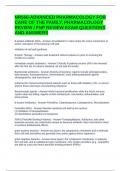NR566-ADVANCED PHARMACOLOGY FOR
CARE OF THE FAMILY, PHARMACOLOGY
REVIEW / FNP REVIEW EXAM QUESTIONS
AND ANSWERS
β-lactam antibiotic MOA - Answer-All antibiotics in class share the same mechanism of
action: disruption of the bacterial cell wall.
Inhibition of cell wall synthesis
Empiric Therapy - Answer-start treatment without cultures or prior to receiving the
results of a culture
immediate empiric antibiotics - Answer-Critically ill patients receive (Fill in the Answer)
after the first set of cultures obtained; do not wait for results.
Bactericidal antibiotics - Answer-Directly kill bacteria: Agents include aminoglycosides,
beta-lactams, fluoroquinolones, metronidazole, most antimycobacterial agents,
streptogramins, and vancomycin.
preferred for immunocompromised patients such as those with diabetes, HIV, or cancer
and for those who have overwhelming infections
Bacteriostatic agents - Answer-inhibit bacterial proliferation while the host's immune
system does the killing. Agents include clindamycin, macrolides, sulfonamides, and
tetracyclines
β-lactam Antibiotics - Answer-Penicillins, Cephalosporins, Carbapenems, Monobactams
Penicillins MOA - Answer-Weaken bacterial cell wall by two actions:
(1) inhibition of transpeptidases
(2) disinhibition (activation) of autolysins.
PBPs (Penicillin Binding Proteins) - Answer-Transpeptidases, Autolysins, and other
bacterial enzymes are collectively named as because antibiotic class must bind to them
to produce antibacterial effects.
gram-positive bacteria - Answer-two layers: the cytoplasmic membrane and a relatively
thick cell wall; penicillins are generally very active against these organisms.
gram-negative bacteria - Answer-three layers: the cytoplasmic membrane, a relatively
thin cell wall, and an additional outer membrane; only certain penicillins (e.g., ampicillin)
are able to cross and reach penicillin binding proteins (PBPs)
,Four Major Groups of Penicillins - Answer-(1) narrow-spectrum penicillins that are
penicillinase sensitive
(2) narrow-spectrum penicillins that are penicillinase resistant (antistaphylococcal
penicillins)
(3) broad-spectrum penicillins (aminopenicillins)
(4) extended-spectrum penicillins (antipseudomonal penicillins).
narrow-spectrum penicillins: Penicillinase sensitive penicillins - Answer-Penicillin G,
Penicillin V
narrow-spectrum penicillinase sensitive susceptible pathogens - Answer-Streptococci,
Neisseria, anaerobes
very narrow antimicrobial spectrum and are used only against penicillinase-producing
strains of staphylococci (S. aureus and S. epidermidis). - Answer-narrow-spectrum
penicillins: penicillinase resistant penicillins
narrow-spectrum penicillins: penicillinase resistant penicillins - Answer-Nafcillin,
Oxacillin, Dicloxacillin
narrow-spectrum- penicillinase resistant susceptible pathogens - Answer-S. Aureus, S.
Epidermidis
Drugs of choice for most staphylococcal infections - Answer-penicillinase-resistant
penicillins (Nafcillin, Oxacillin, Dicloxacillin)
Broad spectrum Penicillin: Aminopenicillins - Answer-Ampicillin, Amoxicillin
Broad spectrum Aminopenicillin susceptible pathogens - Answer-Haemophilus
influenzae, Escherichia coli, Proteus mirabilis, enterococci, Neisseria gonorrhoeae
Extended spectrum penicillins (antipseudomonal penicillin) - Answer-Piperacillin
Has the same antimicrobial spectrum as penicillin G, plus increased activity against
certain gram-negative bacilli, including Haemophilus influenzae, Escherichia coli, and
Salmonella and Shigella - Answer-Broad spectrum Penicillin: Aminopenicillins
First line for acute otitis media and sinusitis - Answer-Amoxicillin
Extended spectrum penicillins suceptible pathogens - Answer-Haemophilus influenzae,
Escherichia coli, Proteus mirabilis, enterococci, Neisseria gonorrhoeae, pseudomonas,
enterobactor, klebsiella
,Principle pathogenic target of Piperacillin - Answer-Pseudomonas aeruginosa
beta-lactamase inhibitors to broaden penicillin spectrum - Answer-clavulanate,
sulbactam, tazobactam
Penicillin/Beta-Lactamase Combinations - Answer-Ampicillin/sulbactam (Unasyn)
Amoxicillin/clavulanate (Augmentin)
Piperacillin/tazobactam (Zosyn)
MRSA Drug of Choice - Answer-Vancomycin
Most Important AE of Penicillins - Answer-Hypersensitivity Reaction
Drug of choice when history of anaphylaxis or some other severe allergic reaction to
penicillins - Answer-Avoid cephalosporin;
Vancomycin, erythromycin, and clindamycin are effective and safe alternatives for
patients with penicillin allergy.
Common drug used to treat bacterial infections in children. - Answer-Penicillins
First line treatment for infection following animal or human bites -
Answer-Amoxicillin/clavulanate (Augmentin)
Medication common for streptococcal pharyngitis - Answer-Penicillin
Penicillin Risk in Pregnancy - Answer-evidence suggests there is no second or third
trimester fetal risk
Penicillin Risk in Infants - Answer-Used safely in infants with bacterial infections,
including syphilis, meningitis, and group A streptococcus.
Amoxicillin - Answer-Safe use during breastfeeding
Penicillin Use in Older Adults - Answer-Doses should be adjusted in older adults with
renal dysfunction.
Cephalosporins - Answer-β-lactam antibiotics similar in structure and actions to the
penicillins.
Are bactericidal, often resistant to β-lactamases, and active against a broad spectrum of
pathogens.
Useful alternative with mild penicillin allergy
Cephalosporins MOA - Answer-Bactericidal drug similar to penicillins that bind to
penicillin-binding proteins (PBPs):
(1) disrupt cell wall synthesis
, (2) activate autolysins (enzymes that cleave bonds in the cell wall). The resultant
damage to the cell wall causes death by lysis. Most effective against cells undergoing
active growth and division.
Ceftriaxone (Rocephin) - Answer-Cephalosporin eliminated largely by the liver.
Dosage reduction is not necessary in patients with renal impairment.
Cephalosporin Administration - Answer-poor absorption from the gastrointestinal (GI)
tract, many drugs in this class must be administered parenterally (by the intramuscular
[IM] or intravenous [IV] route).
Cephalosporin Elimination - Answer-Practically all drugs in this class are eliminated by
the kidneys; patients with renal insufficiency, dosages of drugs must be reduced (to
prevent accumulation to toxic levels).
Cephalosporin Monitoring - Answer-Check renal function if prolonged therapy
Cephalosporin Main Adverse Event - Answer-Hypersensitivity reactions are the most
frequent adverse events.
Cephalosporins — Cefazolin, Cefotetan - Answer-can induce a state of alcohol
intolerance (the disulfiram effect) if to ingest alcohol while taking drugs
Cephalosporins - Cefotetan, Cefazolin, Ceftriaxone - Answer-can promote bleeding as
they contain a side chain that interferes with Vitamin K metabolism which can inhibit the
formation of clotting factors; Caution if combines with other agents that promote
bleeding
First generation cephalosporins indication - Answer-Narrow Spectrum
Gram+
Streptococci, Staphylococci, E.coli, K. Pneumoniae
Use in mild penicillin allergy
strep pharyngitis, skin infections, surgical prophylaxis
First generation cephalosporin examples - Answer-Cephazolin; Cephelexin (Keflex)
Second generation cephalosporins indication - Answer--Gram +/-
-H. influenzae, Klebsiella, pneumococci, staphylococci
-Otitis, sinusitis, respiratory tract infection
-More broad than first generation
Second generation cephalosporins examples - Answer-ceFAclor, CeFOXitin,
CeFURoxime (FAkeFOXFUR)
Third generation cephalosporin indication - Answer--Serious Gram (-) bacteria
-Pseudomonas aeruginosa, Neisseria gonorrhoeae, and Klebsiella, Serratia Meningitis




